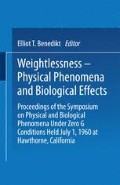Abstract
During the past few years the United States Air Force has been conducting a series of experiments on the effects of weightlessness.* In these series the zero gravity condition is obtained by flying specially equipped aircraft in a precision maneuver (Kep-lerian trajectory) during which time the effects of nearly complete weightlessness are felt by the occupants of the plane. In fighter* type aircraft, the period of weightlessness may extend to 40 sec; however, in such a vehicle, the subject must be strapped into place. In larger aircraft, such as the KC-135, the period of weightlessness may be as long as 32 sec and the subjects can float freely. It is expected that the X-15 aircraft, now under test, will expose the pilot to as much as 4 min of weightlessness. The first Mercury astronaut experienced 5 min of weightlessness. The first reported Russian manned flight is said to have involved about 90 min of zero gravity.
Access this chapter
Tax calculation will be finalised at checkout
Purchases are for personal use only
Preview
Unable to display preview. Download preview PDF.
References
H. J. A. von Beckh, “Experiments with Animals and Human Subjects under Sub- and Zero-Gravity Conditions during the Dive and Parabolic Flight,” J. Aviat. Med. 25, pp. 235–241, 1954. Later published as “La Gravitacion Cero,”pp. 99–110 in “Fisiologia del Vuelo,” Alfa, Buenos Aires, 1955.
Edward L. Brown, and M. R. Rockway, “Research on Human Performance during Zero Gravity,” Human Control Dynamics in Air and Space Craft: Proceedings Second Annual International Air Safety Seminar, Nov., 1958, N.Y., Flight Safety Foundation, Inc.
Arthur C. Clarke, The Exploration of Space. N.Y., Harper & Bros., 1951.
G.T. Crampton, “Vestibular Physiology and Related Parameters in Orbital Flight.” Symposium on Possible Uses of Earth Satellites in Life Sciences Experiments, AIBS, Nat. Acad. Sei., NSF. Wash. D.C., May, 1958.
S.J. Gerathewohl, “Physics and Psychophysics of Weightlessness— Visual Perceptions,” J. Aviat. Med., 23, pp. 373–395, 1952.
S.J. Gerathewohl, H. Strughold, and H.D. Stallings, “Senso-motor Performance during Weightlessness; Eye-Hand Coordination,” J. Aviat. Med., 28, pp. 7–12, 1957.
S.J. Gerathewohl and H.D. Stallings, “The Labyrinthine Posture (Righting) Reflex in the Cat During Weightlessness,” J. Aviat. Med. 28, pp. 345–355, 1957.
Heinz Haber, “The Human Body in Space” Scientific American, 184, pp. 16–19, Jan., 1951.
Heinz Haber and S.J. Gerathewohl, “Physics and Psycho-physics of Weightlessness,” J. Aviat. Med., 22, pp. 180–189, 1951.
J.P. Henry, E.R. Ballinger, P.J. Maher, and D.G. Simons, “Animal Studies of the Subgravity State During Rocket Flight,” J. Aviat. Med., 23, pp. 421–432, 1952.
F.A. Hitchcock, “Some Considerations in Regard to the Physiology of Space Flight,” Astronautica Acta, 2, pp. 20–24, 1956.
Leon A. Knight, “An Approach to the Physiologic Simulation of the Null-Gravity State,” J. Aviat. Med., 29, pp. 283–286, 1958.
A.G. Kousnetzov, “Some Results of Biological Experiments in Rockets and Sputnik II,” J. Aviat. Med., 29, pp. 781–784, 1958.
Edwin Z. Levy, George E. Ruff, and Victor H. Thaler, “Studies in Human Isolation,” J. of the Am. Med. Assoc., 169, pp. 236–239, 1959.
John P. Marbarger, Space Medicine: The Human Factor in Flights Beyond the Earth, Urbana, Univ. of Ill. Press, 1951.
Rodolfo Margaria, “Wide Range Investigations of Acceleration in Man and Animals,” J. Aviat. Med., 29, pp. 855–871, 1958.
George E. Ruff, “Isolation,” Astronautics, Vol. 2, pp. 22–24, Feb., 1959.
D.G. Simons, “Review of Biological Effects of Subgravity and Weightlessness,” Jet Propulsion, 25, pp. 209–211, 1955.
Alan E. Slater, “Sensory Perceptions of the Weightless Condition,” Realities of Space Travel, ed. L. J. Carter. Selected papers of the British Interplanetary Society, London, Putnam, 1957.
Hubertus Strughold, “Medical Problems Involved in Orbital Space Flight,” Jet Propulsion, 26, pp. 745–756, 1956.
Hubertus Strughold, “Mechanoreceptors, Gravireceptors,” J. of Astronautics, 4, pp. 61–63, Winter, 1957.
S. Gordon Vaeth, “Training for Space,” Astronautics, 1, pp. 1–6, 30–32, 1954.
J.E. Ward, W.R. Hawkins, and H. Stallings, “Physiological Response to Subgravity States: II. Mechanics of Nourishment and Deglutition of Solids and Liquids,” USAF-SAM Research Report, J. Aviat. Med. 30, pp. 151–154, 1959.
O.S. Adams, R.B. Levine, and W.D. Chiles, “Research to Investigate Factors Affecting Multiple-Task Psychomotor Performance,” WADC Tech. Rep. 59–120, March, 1959.
O.S. Adams and W.D. Chiles, “Human Performance as a Function of the Work-Rest Cycle,” WADD Tech. Rep. 60–248, March, 1960.
D.E. Graveline, (reported by D. Zylstra), “Astronauts Will Require Less Sleep,” Missiles and Rockets, pp. 33–34, Feb. 29, 1960.
R.F. Gray, “Preliminary Study of Damping of the Otolith Organ System by Epicyclic Rotation,” Naval Air Development Center MA-5919, Task MR 005. 13–6002.1, Report No. 10., Dec, 1959.
A. Graybiel and R.H. Brown, “The Delay in Visual Reorientation Following Exposure to a Change in Direction of Resultant Force on a Human Centrifuge.” Rep. No. 1 USN School Aviat. Med. Res. and Tulane Univ. Joint Rep. No. 3, 1949.
J.A. Kraft, “Measurement of Stress and Fatigue in Flight Crews During Confinement.” Aerospace Med., 30, p. 424, June, 1959.
Raphael B. Levine, “Oculogravic Time-Constant,” unpublished data, May, 1959.
Raphael B. Levine, “Null-Gravity Simulation,” Operations Research Div. Rept. ORD 232, Marietta, Ga., Lockheed Aircraft Corporation, 1960, presented at 31st Annual Meeting of the Aerospace Medical Assn., Miami, May, 1960.
H.J. Muller, “Aproximation to a Gravity-Free Situation for the Human Organism at Moderate Expense,” Science, 128, p. 772, 1958.
O. Schueller, “Space Simulators,” paper in Vistas in Astronautics, Vol. II, 1958.
R.W. Stone, personal communication, Sept., 1959.
Author information
Authors and Affiliations
Editor information
Rights and permissions
Copyright information
© 1961 Springer Science+Business Media New York
About this chapter
Cite this chapter
Levine, R.B. (1961). Zero Gravity Simulation. In: Benedikt, E.T. (eds) Weightlessness—Physical Phenomena and Biological Effects. Springer, Boston, MA. https://doi.org/10.1007/978-1-4899-6279-9_10
Download citation
DOI: https://doi.org/10.1007/978-1-4899-6279-9_10
Publisher Name: Springer, Boston, MA
Print ISBN: 978-1-4899-6152-5
Online ISBN: 978-1-4899-6279-9
eBook Packages: Springer Book Archive

